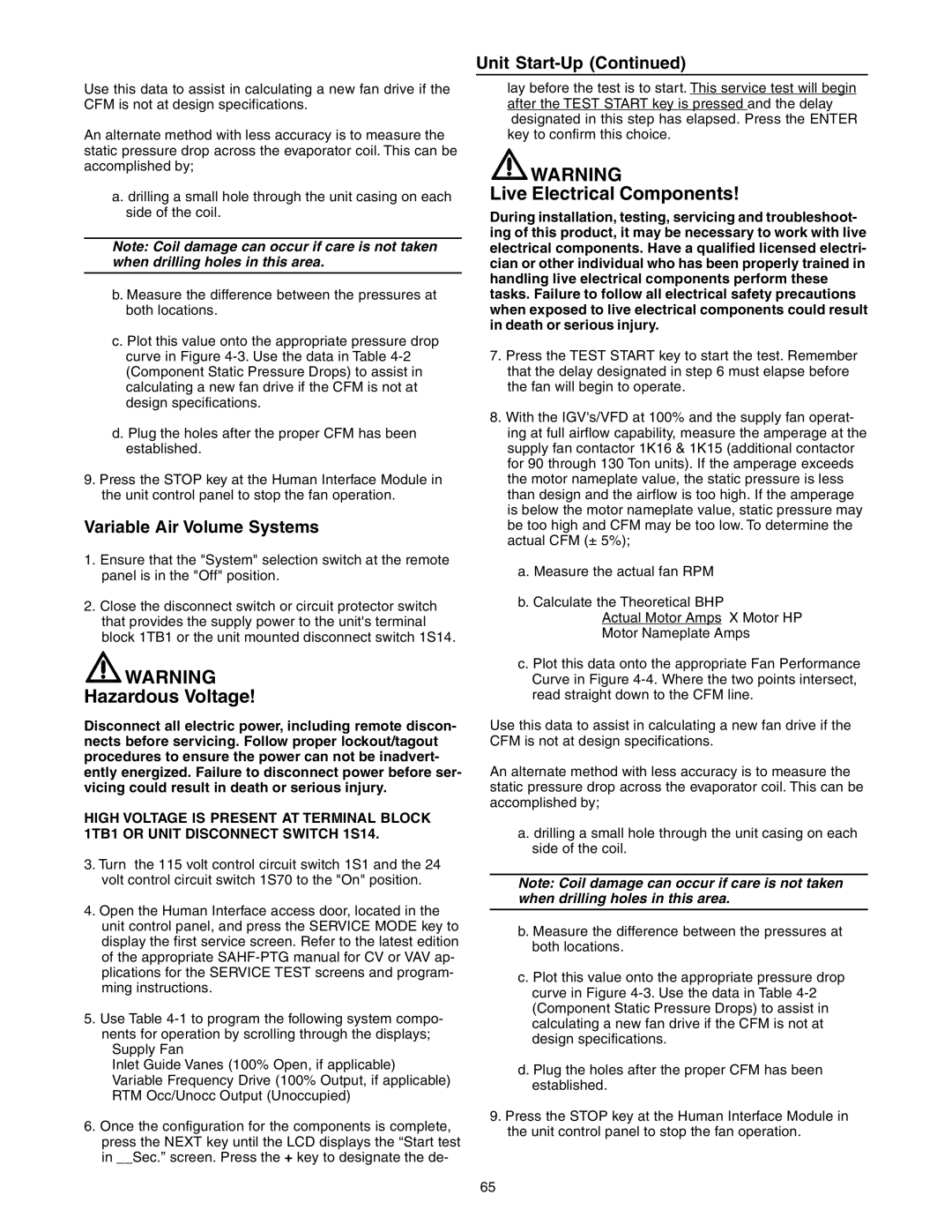
Use this data to assist in calculating a new fan drive if the CFM is not at design specifications.
An alternate method with less accuracy is to measure the static pressure drop across the evaporator coil. This can be accomplished by;
a. drilling a small hole through the unit casing on each side of the coil.
Note: Coil damage can occur if care is not taken when drilling holes in this area.
b. Measure the difference between the pressures at both locations.
c. Plot this value onto the appropriate pressure drop curve in Figure
d. Plug the holes after the proper CFM has been established.
9.Press the STOP key at the Human Interface Module in the unit control panel to stop the fan operation.
Variable Air Volume Systems
1.Ensure that the "System" selection switch at the remote panel is in the "Off" position.
2.Close the disconnect switch or circuit protector switch that provides the supply power to the unit's terminal block 1TB1 or the unit mounted disconnect switch 1S14.
![]() WARNING
WARNING
Hazardous Voltage!
Disconnect all electric power, including remote discon- nects before servicing. Follow proper lockout/tagout procedures to ensure the power can not be inadvert- ently energized. Failure to disconnect power before ser- vicing could result in death or serious injury.
HIGH VOLTAGE IS PRESENT AT TERMINAL BLOCK 1TB1 OR UNIT DISCONNECT SWITCH 1S14.
3.Turn the 115 volt control circuit switch 1S1 and the 24 volt control circuit switch 1S70 to the "On" position.
4.Open the Human Interface access door, located in the unit control panel, and press the SERVICE MODE key to display the first service screen. Refer to the latest edition of the appropriate
5.Use Table
Supply Fan
Inlet Guide Vanes (100% Open, if applicable) Variable Frequency Drive (100% Output, if applicable) RTM Occ/Unocc Output (Unoccupied)
6.Once the configuration for the components is complete, press the NEXT key until the LCD displays the “Start test in __Sec.” screen. Press the + key to designate the de-
Unit Start-Up (Continued)
lay before the test is to start. This service test will begin after the TEST START key is pressed and the delay designated in this step has elapsed. Press the ENTER key to confirm this choice.
![]() WARNING
WARNING
Live Electrical Components!
During installation, testing, servicing and troubleshoot- ing of this product, it may be necessary to work with live electrical components. Have a qualified licensed electri- cian or other individual who has been properly trained in handling live electrical components perform these tasks. Failure to follow all electrical safety precautions when exposed to live electrical components could result in death or serious injury.
7.Press the TEST START key to start the test. Remember that the delay designated in step 6 must elapse before the fan will begin to operate.
8.With the IGV's/VFD at 100% and the supply fan operat- ing at full airflow capability, measure the amperage at the supply fan contactor 1K16 & 1K15 (additional contactor for 90 through 130 Ton units). If the amperage exceeds the motor nameplate value, the static pressure is less than design and the airflow is too high. If the amperage is below the motor nameplate value, static pressure may be too high and CFM may be too low. To determine the actual CFM (± 5%);
a.Measure the actual fan RPM
b.Calculate the Theoretical BHP
Actual Motor Amps X Motor HP
Motor Nameplate Amps
c. Plot this data onto the appropriate Fan Performance Curve in Figure
Use this data to assist in calculating a new fan drive if the CFM is not at design specifications.
An alternate method with less accuracy is to measure the static pressure drop across the evaporator coil. This can be accomplished by;
a. drilling a small hole through the unit casing on each side of the coil.
Note: Coil damage can occur if care is not taken when drilling holes in this area.
b. Measure the difference between the pressures at both locations.
c. Plot this value onto the appropriate pressure drop curve in Figure
d. Plug the holes after the proper CFM has been established.
9.Press the STOP key at the Human Interface Module in the unit control panel to stop the fan operation.
65
